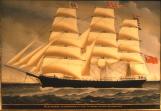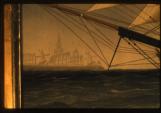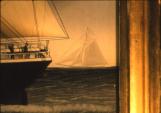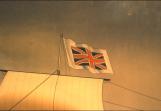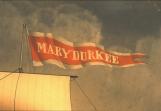1
Using two ship portraits, those of the 'Mary Durkee' and the 'Lillian L. Robbins', this 'story' will point out a number of the interesting facts and other items that can be learned from ship paintings.3
Slide 6.1The ship 'Mary Durkee', built at Meteghan, N.S. in 1861 for Amasa Durkee of Yarmouth, remained under Yarmouth ownership until 1884. Then she was sold to Norwegian interests and re-registered at Drammen under the name 'Magdalena'. She was wrecked in 1889.
Our painting of the 'Mary Durkee' is a 'reverse glass' painting - painted on glass but on the side away from the viewer. That means it had to be painted in reverse order, i.e. the details painted in first with the sky and sea being included last, quite a process! The painting, although not signed, is certainly the work of C.L. Weyts of Antwerp who employed different family members to complete various aspects of the work. For example, one person went to the docks to draw the ship (backwards). This drawing was placed below glass and the painting 'worked up' from the drawing. The gold may have been added by yet another family member.
Please look at the following illustrations numbers to discover a few things about paintings and what they can tell us about the ships they represent. The captions will explain each point.
5
Slide 6.2The caption provides 'written' information and gives the ship's name, its port of registry, the captain's name as well as the ship's location and the date: ' 'Mary Durkee', of Yarmouth, N.S.' and 'Capt. A. Crosby Passing Flushing 1867'. Often, although not in this case, we can find the artist's name, his location and the date the painting was completed.
7
Slide 6.3And here is Flushing in the misty background, complete with Dutch windmills, church steeples and gabled houses. Flushing is the entrance to the River Schelde (sometimes spelled 'Scheldt') which leads to Antwerp - one of Europe's busiest ports and one which was frequently visited by Yarmouth sailing vessels. The ship's figurehead is probably a likeness of either Mary Durkee, the owner's wife, or Mary Durkee, their daughter.
9
Slide 6.4Also in the hazy background can be seen a pilot cutter. This was the boat, in this case a single masted vessel called a 'cutter', which was used to put a pilot aboard a vessel or to take one off. A pilot was a seaman, usually as 'Master Mariner', who was very knowledgeable about the entrance to a specific port. He would know and understand where all the dangers to navigation were, the tidal or river currents and other particularities of the area. Once he came aboard, the ship's captain, who may not be familiar with the area, would turn over control of the ship to the pilot (although he might still overrule the pilot if he thought the ship was in danger). The pilot would then take the ship in. When the vessel was ready to leave port the pilot would again come aboard until the vessel was safely out to sea whereupon he would be picked up by the patrolling pilot boat.
11
Slide 6.5British or Canadian ships in the days of sail would hoist this flag when entering a port if a pilot was required. A 'pilot' was a seaman, usually a Master Mariner, who knew the dangers and channels of a specific port in detail, and who would board the vessel to ensure its safety when entering or leaving that port.
Many of the museum's ship portraits show vessels with their 'pilot flag' flying at the 'foremast peak' (the top of the foremast). Inevitably these paintings also show the pilot vessel, a small sloop or schooner-rigged vessel, approaching with the pilot on board.
13
Slide 6.6At the top of the mainmast is flying the ship's name pennant. The word 'pennant' is used to denote a long thin, usually tapering, flag. The 'Mary Durkee' pennant would likely have been made by the ship's sailmaker, if one was carried aboard, or perhaps even by the captain or his wife.
Sometimes, in place of the name pennant, the ship's 'house flag' (the owner's flag) could be seen in this position. The 'house flag' is often seen in portraits which were commissioned for the owner rather than for the captain - not the case with this painting of the 'Mary Durkee'.
